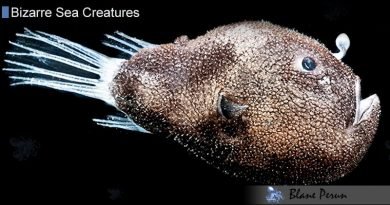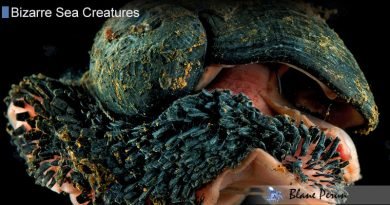The Vampire Squid
Vampire Squid
The Vampire Squid (Vampyroteuthis infernalis) is one of the most fascinating and misunderstood creatures of the deep ocean. Despite its sinister name—which translates to “vampire squid from hell”—this small, gelatinous cephalopod is more a marvel of adaptation than menace. Reaching only about 6 inches in length, it thrives in the dark, oxygen-deprived depths of the sea, using bioluminescence and extraordinary physiology to survive where few organisms can. Like other bizarre sea creatures, the vampire squid challenges what we know about life in extreme environments, offering clues to how species evolve and adapt under conditions of near-total darkness.
Introduction to the Vampire Squid
Discovered in 1903, the Vampire Squid is a deep-sea cephalopod inhabiting the oxygen minimum zones (OMZ) of tropical and temperate oceans, typically between 600 and 900 meters deep. Though its name suggests a fearsome predator, the vampire squid is gentle by comparison to true squids. Its gelatinous body, large eyes, and unique swimming style give it an otherworldly grace, more reminiscent of a drifting jellyfish than a hunter of the abyss.
Anatomy and Physical Characteristics
Body Structure and Size
The vampire squid’s body is soft and translucent, with a pair of wing-like fins that propel it through the water. Its eight arms are connected by a dark web of skin, giving it a cloak-like appearance when spread—one of the traits that inspired its eerie name. Despite its fragile build, the squid’s beak-like jaws are strong enough to crush crustacean shells.
Eyes and Coloration
One of the most remarkable features of the vampire squid is its enormous eyes, proportionally the largest of any animal on Earth. Depending on the angle of light, they can appear red, blue, or violet—an adaptation to the perpetual twilight of its environment. This incredible visual range allows it to detect faint glimmers of light, such as those emitted by other bioluminescent species.
Light-Producing Organs
The squid’s body is equipped with specialized light organs called photophores, which can emit pulses or sustained glows. These lights help it camouflage by counter-illumination, confuse predators, or attract prey drifting through the dark.
Adaptations for Deep-Sea Survival
Oxygen-Minimum Zone Adaptation
Living in oxygen-depleted regions requires exceptional biological efficiency. The Vampire Squid has the lowest mass-specific metabolic rate of any cephalopod and a highly efficient oxygen-transport molecule, hemocyanin, allowing it to survive in conditions where most marine life cannot. Its enlarged gills further enhance oxygen absorption from the surrounding water.
Defense Mechanisms
When threatened, the vampire squid does not expel ink like its shallow-water relatives. Instead, it ejects a glowing cloud of bioluminescent mucus, a dazzling display that distracts predators. It can also turn itself inside-out by inverting its webbed arms, exposing spiny projections as a deterrent while shielding its vital organs—a unique tactic among deep-sea animals.
Feeding Habits and Diet
Contrary to its fearsome name, the Vampire Squid is not a bloodsucker or an active predator. It primarily consumes “marine snow”—a mixture of decaying organic matter, plankton, and microscopic debris falling from the upper ocean layers. Using its long, filamentous feeding tentacles, it collects these nutrient-rich particles from the water column, effectively recycling energy within the deep-sea ecosystem. This scavenging role is vital for nutrient cycling, much like other deep-sea detritivores such as the sea pig.
Habitat and Distribution
The Vampire Squid inhabits tropical and temperate waters worldwide, particularly in the Atlantic, Pacific, and Indian Oceans. It dwells primarily within the mesopelagic and bathypelagic zones—depths between 600 and 1,200 meters—where it experiences near-freezing temperatures and perpetual darkness. Despite the inhospitable environment, the vampire squid’s efficient metabolism and energy-saving locomotion allow it to thrive in these extreme depths alongside other remarkable species like the deep-sea anglerfish and viperfish.
Reproduction and Life Cycle
Little is known about the reproduction of Vampire Squid, as most specimens perish shortly after being brought to the surface. However, research indicates that females may reproduce multiple times throughout their lifespan, an unusual trait among cephalopods. Growth is gradual, with fin position and body proportions changing as individuals mature. The absence of a defined breeding season suggests an adaptation to the stable but resource-limited conditions of the deep sea.
Ecological Role and Conservation
The Vampire Squid plays an essential role in the deep-sea ecosystem as both a scavenger and prey species. By recycling organic matter, it helps maintain nutrient flow between oceanic layers. It is, in turn, preyed upon by deep-diving mammals, including whales and seals, as well as large fish species. While currently not considered threatened, conservation of deep-sea environments remains vital. Activities such as deep-sea mining and climate-induced oxygen loss could disrupt the delicate balance of these ecosystems and threaten species like the vampire squid that depend on them.
Conclusion
The Vampire Squid is a true ambassador of the deep—a creature that embodies life’s ability to adapt and flourish under the harshest conditions. With its glowing arms, silent grace, and unique biology, it continues to fascinate scientists and inspire exploration of the ocean’s least-known realms. Sharing its habitat with other enigmatic species such as the Cuvier’s beaked whale and frilled shark, the vampire squid stands as a living testament to the resilience and creativity of evolution in the deep sea. As we continue to explore these remote worlds, the mysteries of the vampire squid remind us that even in darkness, life finds extraordinary ways to thrive.




